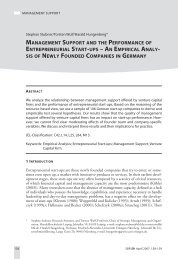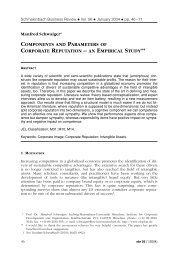“business development”? − the case of biotechnology - sbr ...
“business development”? − the case of biotechnology - sbr ...
“business development”? − the case of biotechnology - sbr ...
You also want an ePaper? Increase the reach of your titles
YUMPU automatically turns print PDFs into web optimized ePapers that Google loves.
S. KIND/D. ZU KNYPHAUSEN-AUFSESS<br />
Operationalizing<br />
<strong>of</strong> corporate<br />
strategies and<br />
clarifying <strong>the</strong><br />
strategic direction<br />
<strong>of</strong> <strong>the</strong> company;communicating<br />
<strong>the</strong> strategy<br />
to external<br />
stakeholders<br />
and potential<br />
partners<br />
“BD belongs to <strong>the</strong> business operation: project definitions, in and out licensing<br />
<strong>of</strong> technologies and patents. BD is <strong>the</strong> positioning <strong>of</strong> <strong>the</strong> company,<br />
for example through mergers and acquisitions. BD starts with <strong>the</strong> definition<br />
<strong>of</strong> projects and identification <strong>of</strong> adequate partners.” (NOXXON Pharma)<br />
“The strategy is mainly developed by <strong>the</strong> CEO and <strong>the</strong> senior management<br />
team; those are seven people in our company that basically do not<br />
come from <strong>the</strong> BD. The management and board <strong>of</strong> directors focus on <strong>the</strong><br />
development <strong>of</strong> strategies. The task <strong>of</strong> <strong>the</strong> BD is to implement <strong>the</strong> strategies<br />
from <strong>the</strong> management team, which does not mean that our ideas do<br />
not influence <strong>the</strong> strategies. We can certainly communicate our ideas to<br />
<strong>the</strong> senior management, but, what we mainly do in <strong>the</strong> BD is implement<br />
strategies.” (GPC Biotech)<br />
“First, communicating <strong>the</strong> strategic direction <strong>of</strong> <strong>the</strong> company. Second, <strong>the</strong><br />
activities are focused on R&D. This is not always <strong>the</strong> R&D director’s job,<br />
and sometimes he is not even able to do this work. That’s why we do it<br />
toge<strong>the</strong>r. Third, <strong>the</strong> projects have to be implemented outside, this means<br />
that <strong>the</strong> company and <strong>the</strong> strategies have to be ‘sold’ to <strong>the</strong> outside: […]<br />
On <strong>the</strong> one hand, I conducted a balance <strong>of</strong> <strong>the</strong> strategic direction. On <strong>the</strong><br />
o<strong>the</strong>r hand, <strong>the</strong> projects were adapted to <strong>the</strong> strategic guidelines. We tried<br />
to identify <strong>the</strong> gaps and find out how <strong>the</strong>y can be closed, if this can be<br />
done by ourselves, or if we have to try to acquire licenses.” (MPB Cologne)<br />
Moreover, BD has to ensure that <strong>the</strong>re are research and development or throughput deals<br />
that enhance <strong>the</strong> value <strong>of</strong> existing products and technologies. Since most product<br />
companies specialize only on very few steps <strong>of</strong> <strong>the</strong> value chain, <strong>the</strong>re are many opportunities<br />
for cooperation (partnering) with o<strong>the</strong>r fi rms in order to cover more steps <strong>of</strong><br />
<strong>the</strong> value chain, and thus to streng<strong>the</strong>n <strong>the</strong>ir position vis-à-vis <strong>the</strong>ir contract partners<br />
(mostly big pharmaceutical fi rms). E.g., Bi<strong>of</strong>rontera cooperated with bioLEADS GmbH<br />
to gain access to bioLEADS’ substance libraries, and Axxima and Wilex partnered with<br />
4SC for screening and optimizing services. Similarly, platform companies <strong>of</strong>ten need to<br />
optimize <strong>the</strong>ir technology portfolios, leading to alliances such as those between Xerion<br />
with T.I.L.L. Photonics GmbH to improve Xerion’s XCALIbur ® technology, or between<br />
Micromet and Biovation, Ltd., to improve Micromet’s antibody technology.<br />
(2) It is also <strong>the</strong> task <strong>of</strong> BD to support <strong>the</strong> commercialization <strong>of</strong> products and technologies,<br />
i.e., to make money by fi nding liquid contract partners for output deals. For<br />
product companies, those contract partners are usually <strong>the</strong> big pharmaceutical companies,<br />
such as <strong>the</strong> Italian company Novuspharma, which paid €4 million upfront to<br />
Micromet and was expected to make additional milestone payments for <strong>the</strong> completion<br />
<strong>of</strong> a joint Phase II study. (We call those deals big pharma deals.) Platform companies,<br />
on <strong>the</strong> o<strong>the</strong>r hand, must license <strong>the</strong>ir technologies to o<strong>the</strong>r research companies, ei<strong>the</strong>r<br />
on a fee-for-service basis or by receiving milestone payments or a fi xed fee in combina-<br />
184 SBR 59 April 2007 176-199






